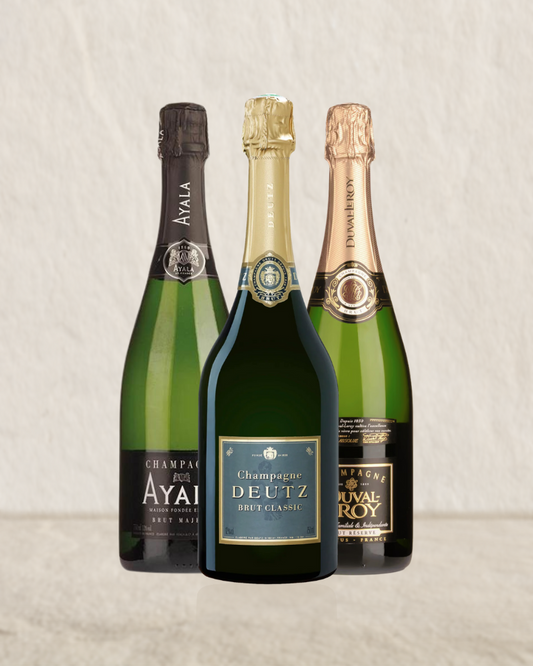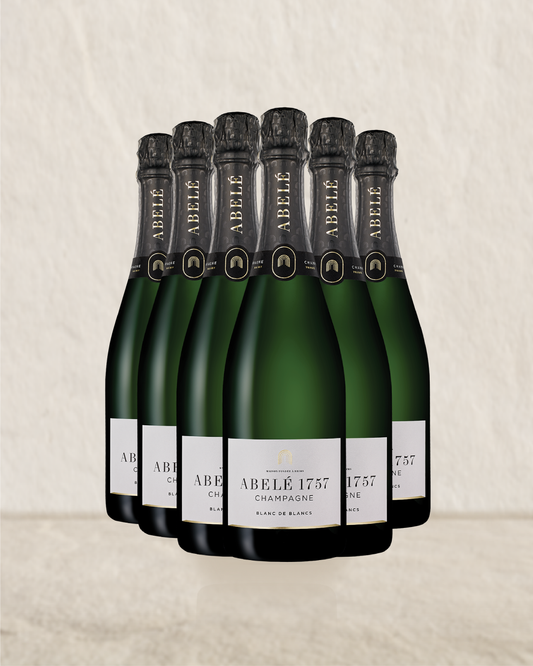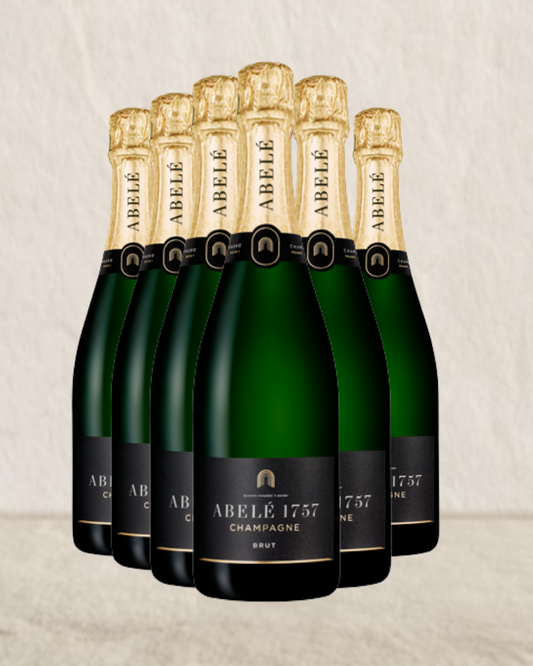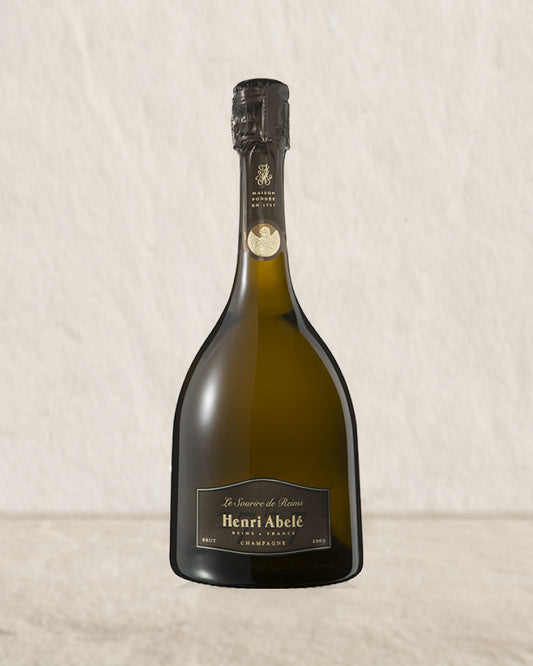Now to the uninitiated, all Champagnes may appear the same- but the permeations available are as wide and varied as the producers themselves.
The options of grape variety, source of material, degree of dosage, and an endless choice of vintage material allow a myriad of styles.
To become familiar with all that is possible is a fascinating and ongoing pleasure.
Non-Vintage (Sans Annee) - This is the benchmark of all houses, as this is the signature of the brand. It is also the greatest expression of the art of blending. By utilizing the different grape varieties, sourced from different areas and vintages the goal is to produce character and complexity, but also consistency year in and year out. So if you were to purchase a bottle today of your favourite brand, it should taste the same as one purchased last year or one purchased a decade from now.
As Champagne has such a marginal climate, the true talent and art of the blender is highlighted when such goals are achieved.
Non-vintage is estimated to account for between 80-90% of total production. In great years such as 1996 a higher proportion went into vintage and cuvee de prestige whilst in the miserable 2001 most ended up in non-vintage blends.
Vintage- In contrast a vintage wine should reflect the unique character of a vintage with the twist of interpretation from the house style. It can only come from the vintage stated and even the dosage must be from the same year.Produced only in the very best of years, with each vintage having their own unique charm and personality. In the past, quite often there may have only been a few years in a decade that may have been deemed worthy of being declared.Modern viticulture with improved methods of cultivation, and a better understanding and ability to combat pests and diseases have seen vintage releases increase. Global warming appears to also have raised a few questions and know one is sure of what the future will bring. As Champagne is on the viticultural precipice of where the grape can be cultivated- it may become a beacon of what is to come.
Rose has also seen an enormous rise in popularity, possibly due to its versatility with food. There are two methods of production, skin contact or by blending. Skin contact/maceration is the same as that for red wine production whereby the juice is kept in contact with the skins until the desired colour is reached. At this time the juice is taken off the skins and made like any other champagne.
The more common method is the addition of still red wine (about 10-15%)to the blend to achieve the desired colour. The red wine used however, must be a still red wine from Champagne. The blending of red wine with white to produce a rose is unique to Champagne, as the practice is forbidden anywhere else. Although popular from the early nineteenth century, it was never considered to be a serious wine. Clicquot pioneered the style with the release of their 1777. Until the seventies very few producers made a rose and a vintage version was almost unheard of. It was considered to be a drink more suitable for women than men and generally only consumed at weddings. This image has changed, and now the rarest, and some of the most sought after Champagnes are the Rose versions of the flagships Dom Perignon, Cristal, Krug and Dom Ruinart
Blancs de Blancs means “white wine made from white grapes” a specific style that is lighter, crisp and delicate and must be produced from Chardonnay only. Until 1980, three other varieties were also permitted; Pinot blanc, Petit Meslier and Arbanne. Most, predominately come from the Cote des Blancs, but examples can be found from the Aube, Cote de Sezanne and the Vallee de la Marne. Usually the lightest and freshest of styles they also age magnificently. In their youth they will display fresh white floral, apple and mineral notes. As they develop they take on ripe exotic fruit flavours and in maturity take on a golden appearance with an incredibly full and complex nose of coffee beans, toast, honey and walnuts.
For many, this is the entry point where they fall in love with Champagne and for many remains their favourite style. The first commercial Blanc de Blancs to be sold was the Salon 1911, which was an enormous success at Maxim’s in Paris. Salon is still one of the greatest, and along with Taittinger Comtes de Champagne and Krug Clos des Mesnil the finest examples of the style.
Blanc de Noirs not as commonly seen as the Blanc de Blancs, but coming back into favour. They may not have the finesse and elegance of a Blanc de Blanc, but they have their role to play, and in partnering with food come into their own. As they develop they gather smoky notes with animal, spice and mushroom characters which may be too strong for some tastes. The best example is the extremely rare Bollinger Vieilles Vignes Francaises
Late-Disgorged- The first late disgorged wines commercially available were the 1952, 1953 and 1955 vintages from Bollinger released in 1961. Extended time on yeast lees does impart a unique beady, autolytic character and due to the reductive state the wine is in a stasis until disgorged. What this style delivers is vibrant, fresh Champagne with complex, aged aromatics. Bollinger R.D. and Krug Collection are testament to the style, lesser known but equally magnificent are the degorgement tardif wines from Jacquesson. Dom Perignon are now also releasing a range of vintages under their Oenotheque releases
Slightly Sparkling- On the 1st September 1994, Champagne lost the right to use the term Cremant, which was used to describe Champagne that was only slightly sparkling. This is an old style of wine which was very popular in the eighteenth and nineteenth centuries. The literal translation is ‘creaming’, referring to the fact that it is gentler in the mouth due to a lower atmospheric pressure, in the region of 3.6 atmospheres, rather than the usual 6 atmospheres. The lighter mousse is achieved by simply adding less sugar at bottling prior to the second fermentation. The wines do not keep for as long as their normal counterparts, but savoured for their texture and mouthfeel. The most famous example was Mumm’s Cremant de Cramant, now known as simply Mumm de Cramant. The term cremant now applies to other French regions using the same method as Champagne for their sparkling wines, such as Burgundy and Alsace. Outside Champagne the term does not necessarily imply a lower pressure, leading to yet more confusion.
Extra Brut, Brut, Dry, Demi-Sec, and Sec all refer to the levels of dryness in Champagne due to the amount of dosage (liqueur d’expedition; a blend of sugar and older wines) added at bottling. At a recent trip to Champagne Drappier I had the intriguing privilege of tasting liqueur’s dating back to 1969, and they routinely age their liqueurs for up to 25 years. - Their aim not for sweetness, more for roundness and texture.
- 0-6gms/litre – extra brut
- Less than 15gms/litre - brut
- 12-20gms/litre – extra dry, or extra sec
- 17-35gms/litre – dry, or sec
- 35-50gms/litre – Demi-sec
- Over 50gms/litre – Doux
Non-Dose, Brut Integral, Ultra Brut, Brut Sauvage and Sans Sucre indicate that no liqueur d’expedition has been used, and the wines have been topped up at bottling just with still wine. There has been a rise in the styles popularity particularly from the new legion of young grower producers. Dosage in the past could sometimes be used to mask green and unripe fruit, so to be successful at the style requires greater attention to the quality of fruit and its handling. It may be an acquired taste for some, but the sheer fruit purity from the best examples has convinced many. Laurent Perrier has dominated the market since its release of the Grand Vin sans Sucre in 1893, and their excellent current release Ultra-Brut is still the market leader. Very old Champagnes do not necessarily require dosage as there is a roundness and richness acquired with age. Jacquesson’s late-disgorged Champagnes are brilliant wines that show how naturally balanced wines can become with no need for dosage.
Coteaux Champenois- Producers throughout Champagne are also permitted to produce still white, red and rose’ wines (the rarest). Since 1974, marketed as “Coteaux Champenois” (formerly known as vins natures de Champagne) often mentioning their communal origin. Accounting for a miniscule proportion (just over 1,500 hectolitres) of the overall total production, they are rare, as little is exported, but often worth seeking out.
Rose des Riceys- Riceys is made up of the three villages, Ricey-Bas, Ricey-Haute-Rive, and Ricey-Haut situated close to Bar-sur-Seine. Covering an area of 730 hectares it was developed by the monks of the abbeys of Clairvaux and Molesmes, the dukes of Burgundy, and the counts of Champagne. The Riceys rose is produced from only the best pinot grapes grown on the steepest slopes with the best aspect and exposure. It is produced only in the very best of years, and is very rare.
The wines renown dates back centuries to Versailles when it was first introduced by the workmen and masons from Riceys who were brought in for the construction of the foundations of the castle and the many terraces around the estate. Louis XIV was said to be extremely fond of the still rose wine. In only the best of vintages can the wine be produced, and the vines are typically low yielding with an average age of 20-25 years. Only the healthiest of grapes are sought and must have a natural alcohol content of not less than 10 percent by volume. The production sees the selected clusters kept with stalks and placed in a vat where a slight pressing begins the initial fermentation.
The fermentation is constantly monitored hour by hour throughout its two to three and a half day duration. This is to monitor and capture the exact moment when the wine acquires the aromas that are particular to a Ricey’s rose. It is the skill, art and experience that will tell the winemaker when to remove the wine from cask. The unique characteristics of a Riceys rose make it on of the finest rose’s in the whole of France. The colour may vary from year to year depending on the vintage, but generally shows remarkable finesse and lightness on the palate. It has lifted pronounced aromas of ripe red fruits (strawberries, raspberries and blue/blackberries). When allowed the opportunity to develop over a period of years, these aromas will develop with exotic, spicy overtones and is certainly a special wine worthy of seeking out, a good example is an unforgettable experience, they can however be quite expensive
Cuvees de Prestige- The flagship wine of any house, and although always the most expensive, represents the quality the maker believes to be the very best. A typical cuvees de prestige is a blend of the very best grapes from the very best vineyards. The site will have the very best exposure, the oldest vines will be used, the yields will be lower, and the greatest care and attention given at all levels. The period of maturation is always longer than that for vintage, and will often have the most ornate of packaging. There are no special rules for the production of prestige cuvee and may be either vintage or non-vintage
The two most famous examples are Louis Roederer’s Cristal and Moet’s Dom Perignon. Cristal lays claim to be the oldest as it was specifically made for the Russian tsar, but was not commercially sold until the 1950’s with the release of the 1945. Dom Perignon 1921 was the first flagship to be comercially released when launched in 1936. Their success was to lead to most of the other houses following suit.
Bollinger began marketing their R.D. (recently disgorged) range in 1961, and Perrier Jouet launched their Belle Epoque 1964 with their distinct hand-painted bottle to mark Duke Ellingtons 70th. birthday. When Pol Roger launched their Winston Churchill (1975) to honour their greatest customer, it was released in magnum only.
Other fine examples include Taittinger Comtes de Champagne, Dom Ruinart, Laurent Perrier’s Grand Siecle, Philipponat Clos des Goisses, and Veuve Clicquot’s La Grand Dame.







